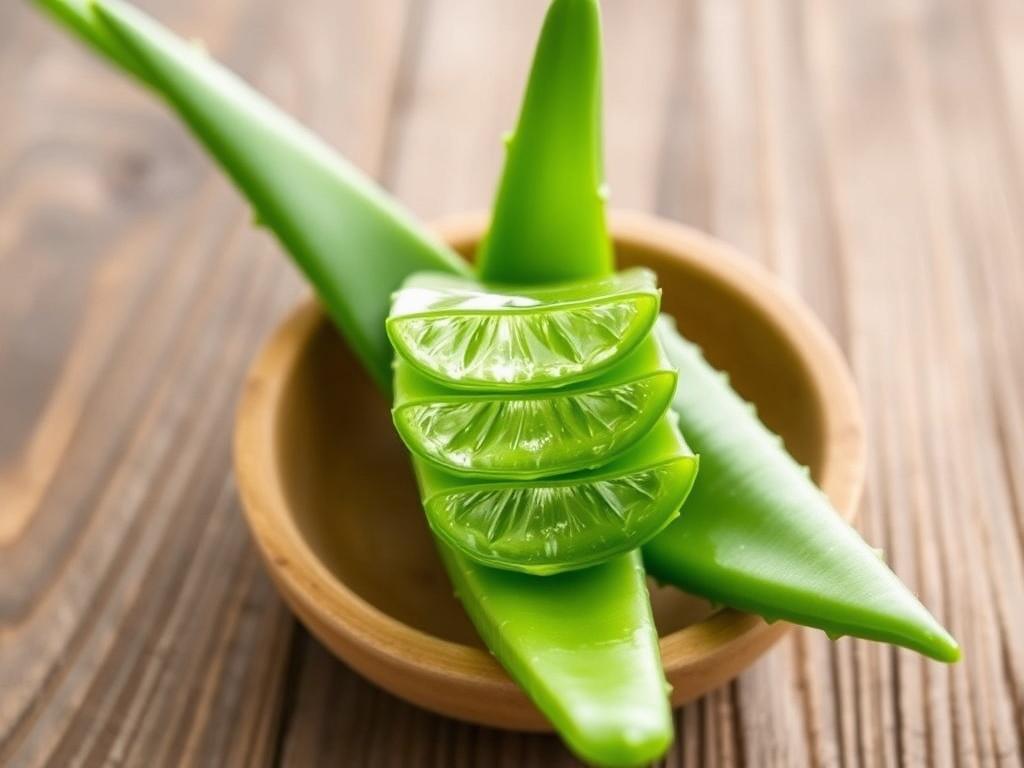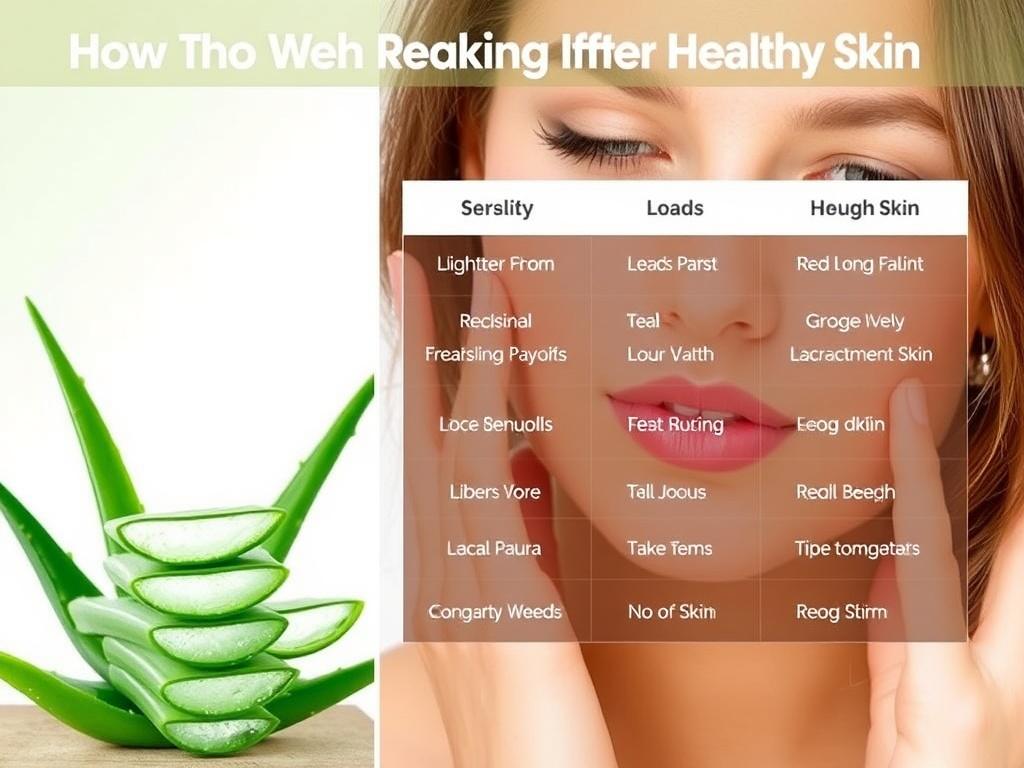Содержание статьи
Aloe vera is often referred to as the “plant of immortality,” and it’s easy to see why. This succulent, with its thick, fleshy leaves filled with a gel-like substance, has been used for centuries for its healing and soothing properties. When it comes to skincare, aloe vera is a powerhouse ingredient that can help improve your skin’s health in numerous ways—and the best part is, it’s natural and readily available. If you’ve ever wondered how to use aloe vera for healthy skin, you’re in the right place. This article will take you through everything you need to know, from understanding what aloe vera does for your skin, to practical tips on incorporating it into your daily routine.
What Makes Aloe Vera So Beneficial for Skin?
Before diving into how to use aloe vera, it’s important to understand why this plant is so beneficial. Aloe vera gel contains a mix of vitamins, minerals, enzymes, and antioxidants that work together to nourish and protect the skin. Some of the key components include vitamins A, C, and E, all of which are antioxidants that help repair damaged skin and keep it youthful. Aloe vera also contains vitamin B12, folic acid, and choline, nutrients that support skin hydration and repair.
Enzymes within aloe vera gently exfoliate your skin by removing dead skin cells, promoting a fresh, clean look. Furthermore, the anti-inflammatory compounds in aloe vera reduce redness and swelling, making it effective for calming irritated skin. Aloe’s natural moisturizing properties ensure your skin stays hydrated without feeling greasy, making it suitable for all skin types—from oily to dry.
How to Prepare Aloe Vera for Skin Care Use

One of the great things about aloe vera is that you don’t always have to buy it in a store. If you have an aloe vera plant at home, you can easily prepare fresh aloe vera gel yourself. Here’s a simple step-by-step guide:
- Cut a mature aloe vera leaf close to the stem using a sharp knife.
- Wash the leaf thoroughly to remove any dirt or residues.
- Slice off the spiky edges carefully on both sides of the leaf.
- Using a knife, peel away the green skin to reveal the transparent gel inside.
- Scoop out the gel with a spoon into a clean bowl.
- For a smoother gel, you can blend it gently in a food processor.
Now you have fresh aloe vera gel ready to use in skin treatments or to mix with other natural ingredients.
Store-Bought Aloe Vera: What to Look For
If you don’t have an aloe vera plant or prefer convenience, store-bought aloe vera gels are widely available. However, not all products are created equal. When choosing a commercial aloe vera gel, look for these factors:
| Feature | Why It Matters |
|---|---|
| Percentage of Aloe Vera | Look for gels with at least 95% pure aloe vera to ensure you’re getting the benefits. |
| Free from Artificial Additives | Avoid products containing alcohol, perfumes, or colors, as they may irritate the skin. |
| Certified Organic | Organic certification guarantees purity and that no harmful chemicals are involved. |
Taking the time to choose high-quality aloe vera ensures your skin reaps the most benefits.
Top Ways to Use Aloe Vera for Healthy Skin
Now that you know why aloe vera is so good for your skin and how to prepare it, let’s explore specific methods for using it effectively. Whether you’re dealing with acne, dryness, or simply want to maintain a glowing complexion, aloe vera can help. Here are some of the most popular and effective ways to use aloe vera for your skin:
1. Aloe Vera as a Daily Moisturizer
One of the simplest uses of aloe vera is as a daily moisturizer. Its lightweight gel provides deep hydration without leaving a greasy residue, making it perfect for all skin types. After cleansing your face, apply a thin layer of fresh or store-bought aloe vera gel by gently massaging it into your skin. This not only locks in moisture but also soothes the skin, making it soft and smooth.
2. Aloe Vera for Acne Treatment
Acne is often accompanied by inflammation and redness, which aloe vera can help calm. The plant’s anti-inflammatory and antibacterial properties reduce acne-causing bacteria and prevent breakouts. To treat acne, apply aloe vera gel directly to the pimples after cleansing your face. You can also combine aloe vera with natural acne-fighting ingredients like tea tree oil or honey for enhanced effects.
3. Sunburn Relief with Aloe Vera
One of the best-known uses of aloe vera is soothing sunburns. The cooling gel reduces redness and inflammation, speeds up healing, and prevents peeling. If you have a sunburn, apply a generous amount of aloe vera gel to the affected areas several times a day for relief.
4. Aloe Vera Face Masks for Glowing Skin
Incorporating aloe vera into face masks is a fantastic way to nourish and refresh your skin. You can mix aloe vera gel with a variety of natural ingredients based on your skin needs:
- Aloe Vera + Honey: Honey moisturizes and has antibacterial effects, great for dry or acne-prone skin.
- Aloe Vera + Turmeric: Turmeric brightens and reduces inflammation, ideal for dull or tired skin.
- Aloe Vera + Yogurt: Yogurt contains lactic acid which gently exfoliates and tightens pores.
Simply blend the ingredients into a smooth paste, apply to your face, leave on for 15-20 minutes, and rinse with lukewarm water.
5. Aloe Vera for Anti-Aging Benefits
The antioxidants in aloe vera can help fight the damaging effects of free radicals that lead to premature skin aging. Regular use of aloe vera can improve skin elasticity, reduce fine lines, and promote a youthful glow. For anti-aging benefits, apply aloe vera gel as part of your nighttime routine, and pair it with a moisturizer rich in vitamins C and E for a powerful combo.
Additional Tips and Precautions When Using Aloe Vera

While aloe vera is gentle and safe for most people, it’s always good to be cautious, especially if you have sensitive skin or allergies. Here are some tips and things to watch out for when using aloe vera on your skin:
- Do a Patch Test: Apply a small amount of aloe vera gel on your inner wrist or behind your ear. Wait 24 hours to check for any allergic reactions like redness, itching, or swelling.
- Avoid Using Aloe Vera on Deep Cuts: While aloe vera heals minor wounds and burns, it may not be suitable for deep wounds or infections—consult with a healthcare professional.
- Store Fresh Aloe Gel Properly: Fresh aloe vera gel kept in the refrigerator lasts about one week. If you want to keep it longer, add a few drops of vitamin E oil as a natural preservative.
- Combine with Other Natural Ingredients: Aloe vera works well with other plant-based skin care elements such as rose water, cucumber, or essential oils to offer enhanced benefits.
Summary Table: Aloe Vera Skin Benefits and Uses

| Benefit | Description | How to Use |
|---|---|---|
| Moisturizing | Hydrates skin without greasiness | Apply fresh gel daily after cleansing |
| Acne Treatment | Reduces bacteria and calms inflammation | Spot treat pimples with aloe vera gel |
| Sunburn Relief | Cools and soothes damaged skin | Apply gel generously on sunburned areas |
| Anti-Aging | Fights free radicals and improves elasticity | Use nightly as part of skincare routine |
| Face Masks | Deep nourishment and skin brightening | Combine with honey, turmeric, or yogurt |
Frequently Asked Questions About Aloe Vera and Skin Care
Can aloe vera cause allergic reactions?
While aloe vera is generally safe, some individuals may experience allergic reactions. It’s wise to conduct a patch test before widespread use.
Is aloe vera safe for all skin types?
Yes, aloe vera is suitable for oily, dry, combination, and sensitive skin due to its gentle moisturizing and soothing properties.
How often should I use aloe vera on my skin?
Aloe vera can be used daily as a moisturizer or as needed for specific issues like sunburn or acne flare-ups.
Can aloe vera replace my regular moisturizer?
For many, aloe vera gel can be a standalone moisturizer. However, some skin types may want to layer it with other products for additional hydration.
Does aloe vera help with dark spots and scars?
Though aloe vera promotes skin healing and cell regeneration, it may take time to see visible improvement in scars and dark spots. Consistent use combined with sun protection is key.
Conclusion
Aloe vera is a remarkable natural remedy that offers a wealth of benefits for healthy skin. Its unique combination of nutrients, antioxidants, and soothing agents makes it an ideal choice for moisturizing, healing, and protecting the skin. Whether you use fresh aloe vera gel from the plant or a high-quality store-bought product, incorporating aloe vera into your skincare routine can help you achieve a glowing, nourished complexion. From calming irritated or sunburned skin to reducing acne and fighting signs of aging, aloe vera proves itself as a versatile and effective ingredient. Remember to observe simple precautions like patch testing and choosing pure products to maximize its benefits. With this comprehensive guide, you are now equipped to enjoy all the natural goodness aloe vera has to offer for your skin’s health and beauty.

